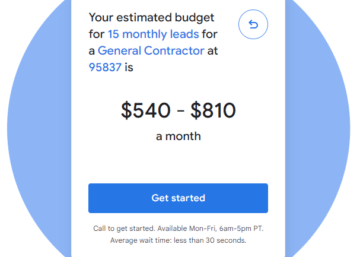Why this marketing agency believes builders, contractors, and remodelers need to diversify their ad spend
As a digital marketing agency, we strongly encourage all of our clients to pursue digital advertising through mediums such as Google Ads. In an economic climate where fewer homeowners are inclined to spend money on large home remodeling projects or new custom home building, it is vital to the success of your construction business that you show up for as many web searches for your services as possible. The best way to do this is to dominate the search engine results page (SERP) real estate.
There are three main places you can show up on a SERP:
- The very top three listings, which are ads
- In what’s called the Local Pack or the Map Pack
- The organic search results (not ads)
Learn more about these different positions on our blog.
At Keokee, we have long extolled the praises of search engine marketing (SEM), also known as paid ads. (See examples one, two, and three.) We have primarily focused on Google Ads for our clients, as Google is the most popular search engine. In fact, Google holds somewhere between 80% and 90% of the global search market. With a near monopoly, we have not ventured to look elsewhere for advertising solutions. Until now.
Reasons to Diversify
Enter the Antitrust. Google has been getting into a lot of trouble with the FTC lately, as well as numerous lawsuits in Europe. With a months-long antitrust case last fall, and more claims against their third-party data practices coming out seemingly daily, Google’s future as the dominant search engine is looking shaky.
Additionally, we started to notice a pattern on many of our clients’ websites – the conversion rates on Bing, DuckDuckGo, and other non-Google search engines were significantly higher than on Google. (In this case, conversion rate is the percentage of users who filled out a contact form while on the website.)
Take a look at these numbers pulled from a client in the Portland, Oregon market over a period of 5 years:
- Total
- Sessions 67,000
- Conversion Rate 2.42%
- Google Ads*
- Sessions 17,530
- Conversion Rate 1.86%
- Google Organic*
- Sessions 17,982
- Conversion Rate 2.42%
- Bing Organic
- Sessions 357
- Conversion Rate 5.88%
- Yahoo Organic
- Sessions 113
- Conversion Rate 7.08%
- DuckDuckGo Organic
- Sessions 111
- Conversion Rate 8.11%
The difference between these different organic conversion rates was shocking to us at first. And then we did more research. If we could harness these higher conversion rates by sending more traffic to the site through these alternative search engines, we could significantly increase lead generation for our clients. After all, we may be involved in most aspects of digital marketing for our clients, but we are first and foremost a lead generation company.
*Please Note: Organic conversion rates are almost always going to be higher than paid search conversion rates.
Market Share in Real Numbers
The previously mentioned anecdote about Google having 80% to 90% of the global market share for web searches makes it seem like investing in alternative search engine ads would not be worth it. But that is where one could be easily fooled.
According to Backlinko.com, there are over 100 million daily active users on Bing worldwide. That may not sound like much compared to Google’s 1 billion, but for small local businesses, that is still a lot of potential clients. And they are a more targeted, ideal demographic.
Multiple Search Engines
Bing Ads show up not only on Bing and Microsoft searches, but also on:
- Aol
- Yahoo
- DuckDuckGo
- Ecosia
- Alexa
- And MORE!
This increases the potential market share reach from roughly 10% to roughly 20% of search engine usage. That doubles the number of potential users we could reach by advertising with Microsoft.
Targeted Demographics
Our clients’ target demographic tends to be older (50+), and much of the initial searching for and ultimate decision making about home services lies with the woman in the relationship. 50% of Bing users are women, and the median age of Bing users is 45.
Bing users tend to be more educated and more affluent. 50% of Bing users have graduated from college. One-third of Bing users have a household income of more than $100,000 annually.
They are more likely to be on a desktop, which makes the searches higher value, as desktop users have a higher conversion rate for our clients.
Bing is ripe with the type of users we are looking to target for our clients.
More In-Depth Targeting
Plus, because Microsoft also owns LinkedIn, the targeting in Bing Ads pulls data from LinkedIn for more specified audience segmentation. This allows us to bid higher for specific job functions and/or companies that the user has listed on their LinkedIn profile.
Cue Ads Diversification
Based on these higher organic conversion rates, more ideal user demographics, and the fact that Microsoft Ads are on average 33% less cost per click than Google Ads, we highly recommend contractors consider diversifying their search marketing ad spend away from Google.



